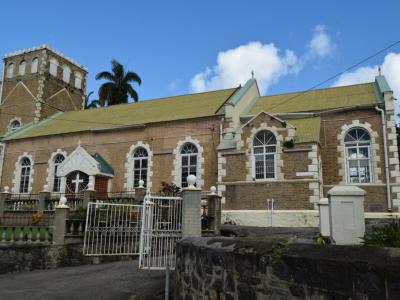Holy Trinity Anglican Church, Castries
The Holy Trinity Anglican Church is an integral part of the Anglican Diocese of the Windward Islands, which is one of eight dioceses within the Province of the West Indies. Construction of the Holy Trinity Anglican Church commenced in 1830 and was completed in 1832. Originally built in a different style, the present brick church was erected in 1894 in the Romanesque Revival architectural style, under the design expertise of architect S.T. Wenbork.
The church's façade features distinctive Romanesque architectural elements, characterized by a white stone Romanesque arch framing the main entrance. A towering spire adorned with louvered windows and rounded arches ascends above the entrance, creating a striking focal point. The tower of the Holy Trinity Anglican Church boasts intricate details, including a staircase leading to a door on the second level and louvered windows with rounded tops adorning each side. A line of stones at the top of the tower forms a crenellated roof, adding to its grandeur.
The north side of the church features large Romanesque style windows framed by white stone blocks, while the south side includes an auxiliary entrance pavilion and additional Romanesque windows. Both sides showcase the meticulous craftsmanship and attention to detail prevalent in the church's design. A two-story addition at the back of the church enhances its functionality and architectural appeal, providing additional space while maintaining the integrity of the original structure.
The church's façade features distinctive Romanesque architectural elements, characterized by a white stone Romanesque arch framing the main entrance. A towering spire adorned with louvered windows and rounded arches ascends above the entrance, creating a striking focal point. The tower of the Holy Trinity Anglican Church boasts intricate details, including a staircase leading to a door on the second level and louvered windows with rounded tops adorning each side. A line of stones at the top of the tower forms a crenellated roof, adding to its grandeur.
The north side of the church features large Romanesque style windows framed by white stone blocks, while the south side includes an auxiliary entrance pavilion and additional Romanesque windows. Both sides showcase the meticulous craftsmanship and attention to detail prevalent in the church's design. A two-story addition at the back of the church enhances its functionality and architectural appeal, providing additional space while maintaining the integrity of the original structure.
Want to visit this sight? Check out these Self-Guided Walking Tours in Castries. Alternatively, you can download the mobile app "GPSmyCity: Walks in 1K+ Cities" from Apple App Store or Google Play Store. The app turns your mobile device to a personal tour guide and it works offline, so no data plan is needed when traveling abroad.
Holy Trinity Anglican Church on Map
Sight Name: Holy Trinity Anglican Church
Sight Location: Castries, St Lucia (See walking tours in Castries)
Sight Type: Religious
Guide(s) Containing This Sight:
Sight Location: Castries, St Lucia (See walking tours in Castries)
Sight Type: Religious
Guide(s) Containing This Sight:
Walking Tours in Castries, St Lucia
Create Your Own Walk in Castries
Creating your own self-guided walk in Castries is easy and fun. Choose the city attractions that you want to see and a walk route map will be created just for you. You can even set your hotel as the start point of the walk.
Castries Introduction Walking Tour
Nobel Prize-winning poet and playwright Derek Walcott could have easily moved on from his home country, both physically and spiritually. His famous line, "The sea is history" proves otherwise. He felt a deep bond with the sea that once "cradled" him.
Castries, the capital of Saint Lucia, stretches along a wide, sheltered bay on the island’s northwest coast. Its name pays... view more
Tour Duration: 2 Hour(s)
Travel Distance: 2.7 Km or 1.7 Miles
Castries, the capital of Saint Lucia, stretches along a wide, sheltered bay on the island’s northwest coast. Its name pays... view more
Tour Duration: 2 Hour(s)
Travel Distance: 2.7 Km or 1.7 Miles




